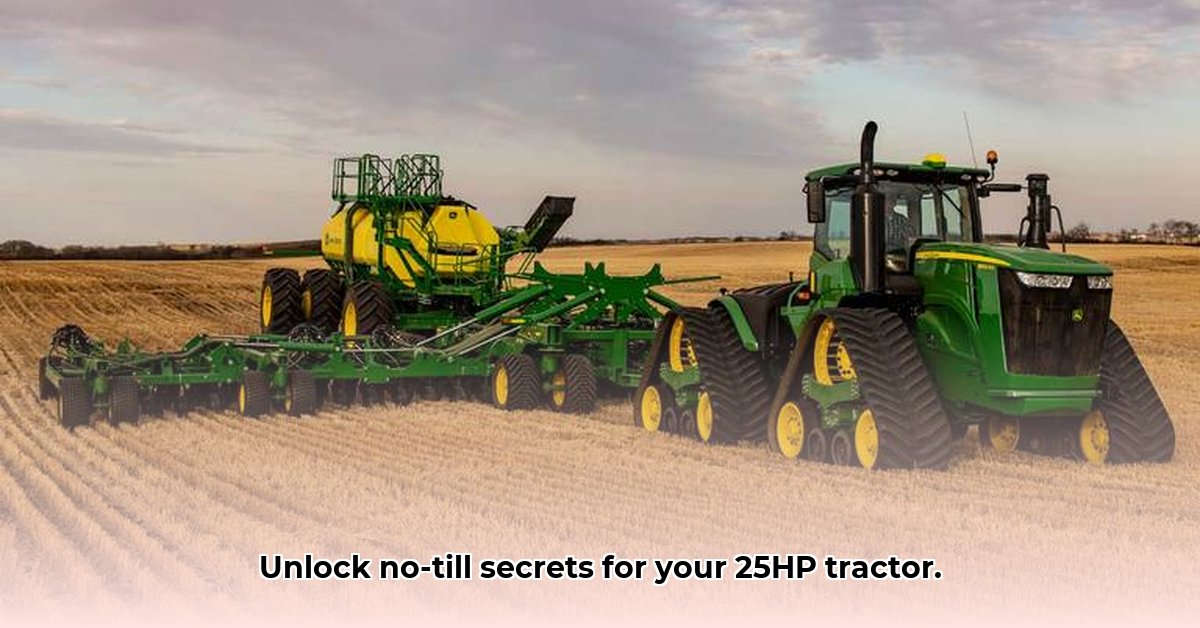
Transitioning to no-till farming with a 25 horsepower tractor? This comprehensive guide helps you choose the right no-till drill, comparing popular brands like Fieldking and Land Pride, and provides setup and operation instructions. Whether you're a seasoned farmer or a newcomer to no-till, we'll cover everything from selecting the ideal machine to maintaining peak performance for optimal results. For more on 25 HP tractors, see this helpful resource: [25 HP Tractor Info](https://25-hp-kubota-tractor.pages.dev).
No-Till Drilling for 25 HP Tractors: A Comparative Analysis
No-till farming, the practice of planting seeds without prior soil disturbance, offers significant benefits: improved soil health, reduced erosion, and lower fuel consumption. But selecting a no-till drill compatible with a 25 hp tractor requires careful consideration. This guide focuses on two leading brands: Fieldking and Land Pride.
Why Choose No-Till?
Before comparing specific models, let's highlight the advantages of no-till. No-till practices minimize soil disruption, preserving soil structure and promoting microbial activity. This leads to improved water infiltration, reduced runoff, and enhanced nutrient cycling. Isn't that a compelling reason to consider a switch?
Fieldking vs. Land Pride: A Detailed Comparison
Both Fieldking and Land Pride offer models suitable for 25 hp tractors. However, key differences exist. The table below summarizes crucial features:
| Feature | Fieldking | Land Pride |
|---|---|---|
| Seed Box Capacity | Varies by model; check specifications | Varies by model; check specifications |
| Seeding Mechanism | Air or vacuum; check model specifications | Air or vacuum; check model specifications |
| Disc Opener Type | Multiple options; model-specific | Multiple options; model-specific |
| Ease of Maintenance | Generally user-friendly; check manual | Generally user-friendly; check manual |
| 25 HP Tractor Compat. | Verify compatibility with specific model | Verify compatibility with specific model |
| Approximate Price | Varies greatly by model and features | Varies greatly by model and features |
Fieldking Advantages: Fieldking drills are often praised for their robust construction and precision seeding capabilities, particularly in models employing air or vacuum seeding mechanisms. However, maintenance requirements vary across their model range.
Land Pride Advantages: Land Pride drills frequently receive positive feedback for their ease of maintenance and user-friendly design. Their simpler designs can minimize downtime. Yet, as with Fieldking, specific features vary substantially across models. Always consult the specifications for the precise model you are considering.
Choosing Wisely: The "best" drill depends entirely on your specific requirements. A larger seed box might be beneficial for larger fields, while a simpler design could be preferable for smaller operations prioritizing ease of maintenance.
Selecting the Ideal No-Till Drill: Beyond the Specifications
Choosing a no-till drill involves more than just comparing specifications. Several crucial factors must be considered:
Budget: Set a realistic budget, encompassing both the initial purchase price and future maintenance costs. Unexpected repairs can significantly impact profitability.
Soil Type: Your soil's characteristics (e.g., clay content, rockiness) directly impact the suitability of different drill types. Consulting your local agricultural extension office or experienced farmers can provide valuable insights.
Intended Crops: The type of crop you intend to plant influences the necessary seed spacing and depth. Ensure the drill's capabilities align with your planting requirements.
Long-Term Soil Health Objectives: No-till farming is a long-term investment in soil health. Choose a drill that supports your long-term goals, such as improved water retention and enhanced nutrient cycling. Will this drill contribute to your goal of improved soil health?
A Step-by-Step Decision-Making Process
Thorough Research: Begin with detailed research into both Fieldking and Land Pride models. Visit their websites, review brochures, and consult independent reviews from fellow farmers.
Narrow Your Choices: Use the comparison table above to eliminate models unsuitable for your budget, soil type, and planting needs.
Dealer Consultation: Contact local dealers to discuss your requirements and obtain personalized recommendations. They can provide valuable insights based on their local experience.
Obtain Quotes: Secure price quotes from multiple dealers for comparable models to ensure you achieve the best possible pricing.
(If Possible) Test Drive: If possible, request a demonstration or test drive to assess the drill's operation and suitability for your needs.
Setting Up and Operating Your No-Till Drill: A Practical Guide
Pre-Planting Preparations:
- Thoroughly read and understand the manufacturer's instruction manual.
- Calibrate the seeding mechanism to ensure accurate planting rates for your selected crop.
- Conduct a comprehensive pre-planting inspection of all components for any signs of damage or wear.
- Ensure proper adjustment of the hitch to your tractor.
Operational Procedures:
- Maintain a consistent speed within the recommended range during planting.
- Regularly monitor the seeding depth and spacing to prevent inconsistencies.
- Constantly check the seed levels in the hopper to prevent interruptions during planting.
Maintenance:
- Clean the drill thoroughly after each use to prevent build-up of residue.
- Lubricate moving parts according to the manufacturer's recommendations.
- Perform regular inspections for wear and tear, promptly replacing any damaged or worn components.
Conclusion: Investing in Your Farm's Future
Selecting a no-till drill is a significant investment. By following this guide and prioritizing thorough research, you can select the perfect machine to achieve your farming goals while enhancing soil health and sustainability. Remember to consult additional resources like your local agricultural extension office for further guidance.